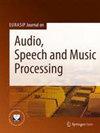使用改进的电磁算法进行稳健的声反射器定位
IF 1.9
3区 计算机科学
Q2 ACOUSTICS
Eurasip Journal on Audio Speech and Music Processing
Pub Date : 2024-04-18
DOI:10.1186/s13636-024-00340-y
引用次数: 0
摘要
在机器人技术中,回声定位被用于探测声反射器,如墙壁,因为它有助于机器人平台在黑暗中导航,也有助于探测透明表面。然而,声学系统(如扬声器/发射器)的传递函数或响应会导致声学系统内的非理想行为,从而由于传播延迟而产生相位滞后。这种非理想响应会妨碍用于声反射体定位的到达时间(TOA)估计器的性能,尤其是在需要估计多次反射的情况下。因此,我们在本文中提出了一种稳健的期望最大化(EM)算法,该算法考虑到了声学系统的响应,以提高机器人放置在房间角落时估计多重反射时的 TOA 估计精度。利用两个参数建立了一个非理想传递函数,并在估算器中对这两个参数进行递归估算。为了测试所提出的方法,我们用两种不同的设计搭建了一个硬件概念验证装置。实验结果表明,在信噪比(SNR)为 0 dB 的情况下,所提出的方法能以 60%$$ 的精度检测到距离为 1.6 m 的声反射器。与最先进的电磁算法相比,我们提出的方法在低信噪比下估计 TOA 的性能提高了 $$10\%$。本文章由计算机程序翻译,如有差异,请以英文原文为准。
Robust acoustic reflector localization using a modified EM algorithm
In robotics, echolocation has been used to detect acoustic reflectors, e.g., walls, as it aids the robotic platform to navigate in darkness and also helps detect transparent surfaces. However, the transfer function or response of an acoustic system, e.g., loudspeakers/emitters, contributes to non-ideal behavior within the acoustic systems that can contribute to a phase lag due to propagation delay. This non-ideal response can hinder the performance of a time-of-arrival (TOA) estimator intended for acoustic reflector localization especially when the estimation of multiple reflections is required. In this paper, we, therefore, propose a robust expectation-maximization (EM) algorithm that takes into account the response of acoustic systems to enhance the TOA estimation accuracy when estimating multiple reflections when the robot is placed in a corner of a room. A non-ideal transfer function is built with two parameters, which are estimated recursively within the estimator. To test the proposed method, a hardware proof-of-concept setup was built with two different designs. The experimental results show that the proposed method could detect an acoustic reflector up to a distance of 1.6 m with $$60\%$$ accuracy under the signal-to-noise ratio (SNR) of 0 dB. Compared to the state-of-the-art EM algorithm, our proposed method provides improved performance when estimating TOA by $$10\%$$ under a low SNR value.
求助全文
通过发布文献求助,成功后即可免费获取论文全文。
去求助
来源期刊

Eurasip Journal on Audio Speech and Music Processing
ACOUSTICS-ENGINEERING, ELECTRICAL & ELECTRONIC
CiteScore
4.10
自引率
4.20%
发文量
0
审稿时长
12 months
期刊介绍:
The aim of “EURASIP Journal on Audio, Speech, and Music Processing” is to bring together researchers, scientists and engineers working on the theory and applications of the processing of various audio signals, with a specific focus on speech and music. EURASIP Journal on Audio, Speech, and Music Processing will be an interdisciplinary journal for the dissemination of all basic and applied aspects of speech communication and audio processes.
 求助内容:
求助内容: 应助结果提醒方式:
应助结果提醒方式:


